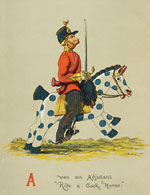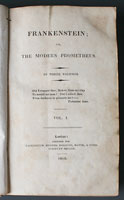Alphabet Soup
A is for Adjutant
A Military Alphabet, Bloomsbury Auctions, London, $585
When Surgeon-Major F.E. Scanlan was not too busy at the operating table, he found time to throw down his scalpel and apply those skilled surgical hands to the palette instead. Scanlan’s A to Z, being Twenty-six Notes on a Soldier’s Trumpet, published in 1876, is a scarce and charming alphabet book illustrated with chromolitho plates. Here we see the opening plate: “A was an Adjutant, Ride a Cock Horse.”
A little spotted and bearing the large ink inscription of a former owner, but still in the original boards, a copy seen in a Bloomsbury Auctions sale of March 25–26 sold at £408 ($585).
D is for Down and Out
Orwell on the Streets—and in the Fields, Bonhams, London, $10,295
An archive of letters addressed by the young Eric Blair (George Orwell) to his friend Dennis Collings in the early 1930s included a couple relating to the experiences he would later use in Down and Out in London and Paris.
Sold at £7,200 ($10,295) to dealer Rick Gekoski was a letter about sleeping rough in Trafalgar Square. On a glacial night, Orwell wrote, he and his companions had been woken and made to stand up at frequent intervals by the police, but around four in the morning someone managed to get hold of a big pile of newspaper posters to use as blankets.
“Ere y’are mate, tuck in the fucking eiderdown. Don’t we look like fucking parsons in these ’ere surplices?”
Orwell also relates the sorry plight of the local prostitutes and tells of a weeping woman whose client had scarpered without paying her sixpence fee. Of the dozen or so women of the square’s night-time population of around 200, half were prostitutes, “but prostitutes of the unemployed... . 6d is the usual fee, but in the small hours when it was bitter cold they were doing it for a cigarette.”
Another dispatch from the field—quite literally—was a letter sent from the Kentish hopfields, where Orwell was again posing as a tramp. Sold at £4,800 ($6,865) to dealer Chris Jonkers, the letter describes the atrocious living conditions endured by hop-pickers: “4 of us live in a tin hut about 12 feet across, with no glass in the window, letting in the rain and draughts on all sides, and furnished only with a large heap of straw.”
Experienced pickers could gather 20 bushels a day, earning a modest sum, but Orwell, on his only full day, managed only half that number, and that “...by half killing myself.”
“Hopping,” he tells Collings, “…is a bloody swindle & only goes on because there is a large supply of casual labourers, ready to do almost anything, & the East Enders rather like a trip to the country.” *
* It occurs to me that a couple of explanatory notes might be useful for U.S. readers. Sixpence was roughly equivalent to a dime, and the East Enders to whom Orwell refers were the poor working classes of London’s East End. Their labours in the hopfields often served as a holiday as well!
F is for Frankenstein
The Reviewer’s Copy, Anderson & Garland, Newcastle, $52,090
Today’s readers, among them teenagers (and parents!) who, almost two centuries later, tackle Frankenstein as a set text for English exams, may struggle with the 18-year-old Mary Shelley’s style. Older and wiser heads may wonder at an understanding and grasp of ideas beyond her years, but the Rev. Robert Morehead, one of the first to review Shelley’s book, had other reservations.
Dean of Edinburgh, and from 1817–26 editor of the Edinburgh Magazine, he disliked Mary’s flaunting of the “established order of nature as it appears, both in the world of matter and mind.” He was more comfortable with Jane Austen and two months later, reviewing Northanger Abbey and Persuasion, he contrasted Jane favourably with Mary for her concentration on the ordinariness and verisimilitude of her characters.
That very review copy of the 1818 first edition, the three volumes, bound as one in period calf, lacked the half-titles and advertisements and there was spotting throughout, but firsts of Frankenstein are rare beasts, and those shortcomings were in some way compensated for by its unusual provenance. It made £36,425 ($52,090).
Some reviewers had been far sterner than Morehead in their dismissal of the book, but Sir Walter Scott, in Morehead’s principal rival, Blackwood’s, wrote “…upon the whole, the work impresses us with a high idea of the author’s original genius and happy power of expression.”
What price, I wonder, would be put on Scott’s review copy—if indeed it still exists?








 Ian McKay’s weekly column in Antiques Trade Gazette has been running for more than 30 years.
Ian McKay’s weekly column in Antiques Trade Gazette has been running for more than 30 years.
